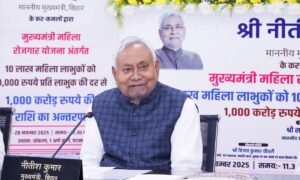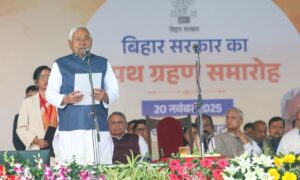![The Union Minister for Finance and Corporate Affairs, Arun Jaitley, (third from left) addressing a Post Budget Press Conference [image courtesy: PIB]](https://impactnews.in/wp-content/uploads/2018/02/Jaitley-addressing-post-budget-session-PIB-1020x478-e1517930267895.jpg)
The Union Minister for Finance and Corporate Affairs, Arun Jaitley, (third from left) addressing a Post Budget Press Conference [image courtesy: PIB]
As the Indian Finance Minister Arun Jaitley rose in Parliament to present the last full budget of the present government before the run up to the general elections due in early 2019, it was clear that environment and climate change were not on his priority list.
The union budget, which allocates central government funds and provides a good flavour of policy direction, was presented in Parliament two days after the Economic Survey 2017-18, which had emphasised the impacts of climate change on the energy and agricultural sectors.
Despite the mention in the most important annual economic document of the central government, Jaitley’s speech was devoid of any significant policy announcements regarding environment and climate change. In fact, he did not even mention renewable energy in his speech, a sector where India has taken a global lead in recent years, in part due to the proactive measures adopted by the present regime.
The budgetary neglect also comes on the heels of India’s poor performance on the Environmental Performance Index released at the annual meeting of the World Economic Forum in the alpine resort of Davos in Switzerland this week. The country was ranked 177 out of 180 nations included in the gauge.
The budgetary allocation for the Ministry of New and Renewable Energy (MNRE), which deals with the solar and wind power sector in India, rose by a mere 9% to INR 103.2 billion (USD 1.6 billion) for the financial year starting April 1. In comparison, MNRE allocations expanded in the past two fiscal years by 37% and 52%, respectively.
“We are not happy with the budget,” Chandra Bhushan, Deputy Director General of Delhi-based think-tank Centre for Science and Environment (CSE), told thethirdpole.net. He said the budget was a “damp squid.”
Renewables sector disappointed
Renewable energy sector executives and experts also voiced their disappointment. “At a time when the industry is facing policy and trade regulation uncertainties, there were some expectations from the budget in terms of significant allocations to meet our renewable energy ambitions,” Kanika Chawla, Senior Programme Lead at think-tank Council on Energy, Environment and Water (CEEW), told thethirdpole.net. “But, with no announcements for the renewable energy sector, the budget has been disappointing.”
India aims to install a renewable energy capacity of 175 GW by 2022. It is now unlikely that the government will achieve this target, according to K. Kasthurirangan, Chairman of industry lobby group Indian Wind Power Association (IWPA). “Incentives that were already there, like 80% accelerated depreciation and tax holidays for renewable energy, were withdrawn last year. Due to this, the investment in renewable energy was appallingly low this year,” he told thethirdpole.net. “Today’s speech was more of promises, but nothing in reality.”
“There are no new significant proposals related to the power or renewable sectors in Budget 2018,” said Anshumaan Bhatnagar, Co-Founder and Director of Sunshot Technologies, a solar power company. “There is nothing in the budget, either on renewable or wind energy,” D. Giri, Secretary General of Indian Wind Turbine Manufacturers Association (IWTMA), told thethirdpole.net. “As far as wind energy is concerned, there is nothing new or nothing that has been offered in the budget. It’s an absolute zero. It’s rather sad that none of our concerns have been addressed.”
Meagre funds for environment
The budgetary allocation for the Ministry of Environment, Forest and Climate Change (MOEFCC) rose by a mere 4.5% for 2018-19 compared with a growth in allocation by 19% for the previous financial year.
The Finance Minister noted progress made in cleaning up the Ganga River in his speech and said on the critical issue of air pollution that has turned Indian cities among the world’s worst-polluted. “Air pollution in the Delhi-NCR (national capital region) region has been a cause of concern. A special scheme will be implemented to support the efforts of the governments of Haryana, Punjab, Uttar Pradesh and the NCT (National Capital Territory) of Delhi to address air pollution and to subsidise machinery required for in-situ management of crop residue,” he said.
Environmentalists reacted sharply to this. “Does air pollution afflict only Delhi?” Bhushan asked. “It is a national budget, and this move is not going to solve country’s air pollution problem as a whole.”
Although Delhi’s air pollution gets the most attention, pollution levels across North India, including in Varanasi, the Prime Minister’s constituency, routinely reach higher levels.
“Sustainable development, climate change, and environment conservation are completely missing in the budget,” Himanshu Thakkar, co-ordinator of activist group South Asia Network on Dams, Rivers and People (SANDRP), told thethirdpole.net. “We are losing groundwater but they have announced groundwater irrigation schemes without focusing on water recharge.”
For cleaning of India’s polluted rivers, the budget has increased fund allocation for the National River Conservation Programme from last year’s INR 7.23 billion (USD 114 million) to INR 7.70 billion (USD 121 million) for 2018-19, an increase of only 6.5%. In another disappointment, funding for the government’s mega Ganga clean-up programme remained the same as last financial year’s INR 23 billion (USD 362 million), showing no growth. This is at a time when inflation in India is expected to average around 5%.
After the National Democratic Alliance led by the Hindu nationalist Bharatiya Janata Party swept to power in 2014, Prime Minister Narendra Modi, who won from Varanasi, a city deemed holy by Hindus, had launched the Namami Gange programme to restore the river that is one of the world’s most-polluted. “Work has gathered speed and 187 projects have been sanctioned for the infrastructure development and river surface cleaning,” finance minister Jaitley said in his speech on February 1, adding that over 4,000 villages on the banks of the Ganga have been declared open defecation free.
“The only schemes (for cleaning Ganga) that are being approved are those that can bring in investments like sewage treatment plants and sewage lines. They are going for same technologies that have not worked in the past without learning the lessons,” Thakkar pointed out. “They are going for riverfront development, investments for waterways, and all these schemes have got nothing to with local governance and neither they include any sort of participation from the people.”
Focus on agriculture
This year’s budget focussed a lot on the agriculture sector. India has been grappling with an agrarian crisis and the farmer discontent has spilled out in the street in recent times. It was expected before the budget that the government would like to present itself as farmer-friendly ahead of 2019 national elections since about 50% of India working population derive their livelihoods from agriculture.
The measures included building market infrastructure for farm produce; increasing the minimum support price at which the government buys produce from farmers by 1.5 times the production cost, and reiterating that it intends to double their income by 2022. However, the Economic Survey has said there could be a drop in the farm income by 20-25% due to climate change.
“Farmers are the biggest sufferers of climate change and they are not even being called victims or are being compensated for the losses they face for no fault of theirs,” Thakkar told thethirdpole.net. “There is no overall commitment on environment, rivers, or climate change issues that affect farmers directly.”
Jaitley also announced a scheme where farmers will be able to irrigate farms with solar pumps and sell the excess power to the electricity grid. But he provided no clarity on how it would be executed.
“The farmers are already selling excess power back to the grid in Gujarat in a pilot scheme. But there’s a lot of work to be done before this can possibly be scaled up. The economics of this is not clear,” a representative of an organisation working with farmers to set up solar irrigation pumps around India told thethirdpole.net. “In the pilot scheme, the farmers get over 50% of their capex (capital expenditure) as subsidy, so paying them for excess power may be seen as double subsidisation. And it’s not clear if the farmers can earn enough money by selling power to break even within 5 years if the capex subsidy is removed.”
This article was originally published in the Third Pole. To read the original article click here
Environment and climate change gets short shrift in India’s budget


















